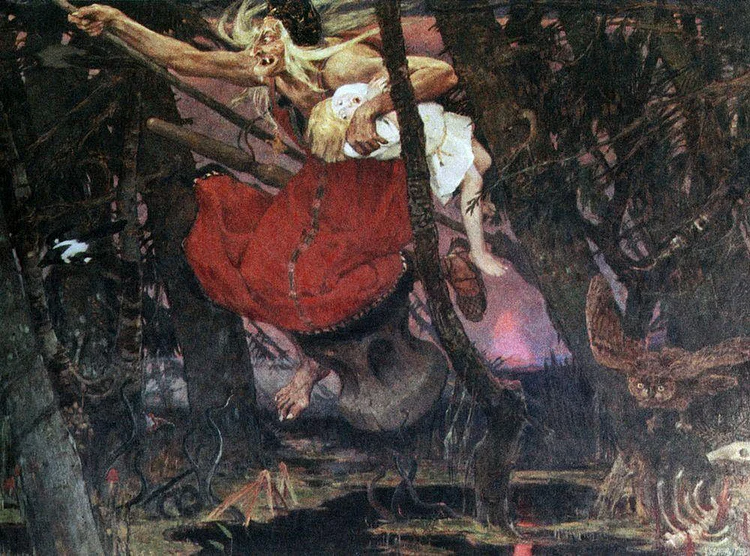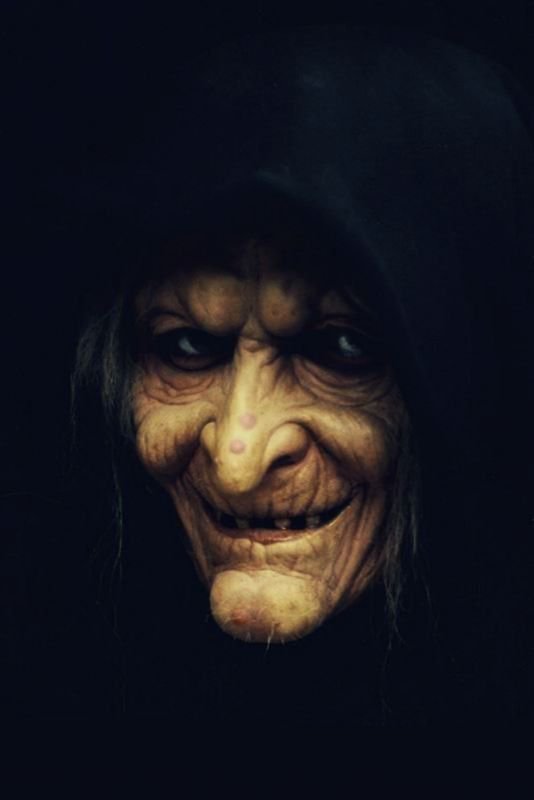
Once war is on men’s minds, Selica had said, it festers within, claiming them.
For a soldier to let his enemy live despite the entrenched inclination to kill touched my heart with a flame. And as he looked out on our land, on the people dying and bleeding on it, no matter if they were Russian or Mongol, I saw pain, deep and endless and raw, open inside him like a ravine about to swallow us. There was light there, light that left me hopeful. Perhaps life, possibly even goodness, did exist, even in a soldier, and it prevailed in the world after all.
Baba Yaga, aka Bony Legs, has gotten a bad rap. Ivan the Terrible, however, deserves all the lousy press that can be heaped upon him. Terrible seems far too tame a word, The monstrous, the psycho-killer, the unspeakable, the mindless slayer of mankind, and on, and on, [insert your pejorative here]. (Of course, this is the portrait presented in the book. The real-life Ivan may have had cause for his paranoia, given the considerable opposition of the gentry to many of his policies. Find out more in this small piece in Britannica.)

Olesya Salnikova Gilmore – image from her site
The most common images of Yaga are of a frightening witch, tooling about in a strange vehicle, trapping and devouring children, and generally doing dirt to people, a personification of evil. But even in traditional lore, she is sometimes shown with a softer side, a healer instead of a tormenter, a consoler, a comforter instead of a horror. She has been seen as a personification of nature, a Slavic version of Persephone. She appears as a change agent in many stories, a trickster, helping the hero or heroine fulfill their quest.

Image from The House of Twigs
I had written two books that had gone nowhere. Totally uninspired, almost desperate, I turned to the Russian folktales I had grown up with as a child. Baba Yaga loomed large in these stories—her elusive and mercurial character, her enchanting chicken-legged hut, her terrific mortar and pestle mode of transport, her sharp tongue and fearsome appearance, unsurprising for a woman of knowledge living alone in the wood.
As it turns out, some scholars believe the Baba Yaga we know—the old, ugly hag from the fairy tales—is based on, or is a descendent of, a fertility and earth goddess worshiped by ancient pagan Slavs. I was instantly fascinated by how a goddess could become a witch and just knew I had to write a book not about the infamous hag, but about the little-known woman named Yaga.
– from the Writer’s Digest interview

A painting portraying Baba Yaga. According to Slavic folklore, Baba Yaga was a witch who often preys on children to eat them. However, some accounts present her as a wise and helpful creature. The painting was created in 1917 and is now located at the House Museum of Viktor Vasnetsov in Moscow.
Gilmore is looking to give Yaga some better press, make her more human in some ways, more of a bad-ass superhero in others. She has a team, of course. (Y-men?) The house on chicken legs that is the very definition of creepy, has been transformed into Little Hen, a supportive, nurturing friendly character who might have been the original mobile home. When Yaga speaks to Little Hen she regards her as somewhere between a beloved pet and a partner. Dyen (meaning day) is a considerable wolf. He (thankfully) is Yaga’s primary means of high speed transportation, while also offering his considerable fierceness. Noch (meaning night) is an owl. Noch specializes in reconnaissance and intel-gathering. They share Yaga’s immortality.

Xénia Hoffmeisterová [cs], Ježibaba [cs] (2000)
As a provider of potions for this and that, Yaga has a following. Among those is the tsar’s wife, the tsaritsa, whom she has known for a long time. She is suffering from an illness that the court physicians cannot seem to touch. Yaga helps her out, but suspects foul play. Although she would prefer to remain safely in her house in the woods, she must go to Moscow to find out who is doing this to Anastasia Romanovna, a kind, sweet young woman. It would appear that Yaga and crew are not the only immortals wandering about. The tsar has fallen under the influence of a dark-hearted ageless sort, someone Yaga knows. And the game is afoot.

Image from King Edward’s Music
Tsar Ivan is not exactly the best administrator, and it is not long before he is laying waste to large swaths of the country, under the guidance of a dark force. Whether getting there because of his genetic inheritance, or because his mind had been poisoned by a demonic sort, (The actual Ivan was quite superstitious, taking an interest in witchcraft and the occult.) Ivan, who seems at least somewhat rational when we meet him, is soon barking mad, seeing enemies everywhere, even among friends, and showing no hesitation about slaughtering anyone who displeases him. Yaga loves her Mother Russia and considers it her patriotic duty to defend her against enemies foreign and domestic. Ivan definitely counts among the latter. So, superhero vs supervillain.

Ivan Bilibin, Baba Yaga, illustration in 1911 from “The tale of the three tsar’s wonders and of Ivashka, the priest’s son” (A. S. Roslavlev)
There are levels of existence here with diverse characteristics, lands of the dead and living, a glass mountain, with spells aplenty. Yaga’s adventures might remind you of western mythology and Campbellian quest forms having to do with descending to hell in order to emerge better armed to take on whatever. Yaga needs help from other immortal sorts to accomplish her mission, which becomes pointedly clear later in the book. In the shorter term, she is faced with carnage in Russia, and trying to find ways to stop or even just slow it down.

Baba Yaga depicted in Tales of the Russian People (published by V. A. Gatsuk in Moscow in 1894)
There is even a bit of romance to counterbalance some of the considerable blood-letting.
After I had witnessed my first birthing not ten years into my life, Mokosh had explained to me the intricacies of lovemaking and child making. “Though immortals can birth other gods and half gods,” she had said, gently, “it is not simple for us, with mortals above all. Most of the time, it happens not. It is even harder for half gods. If it happens, it does so for a reason. It is willed by the Universe.” I had known many men over the centuries, both mortal and immortal. Not once had my trysts ended in anything other than fleeting pleasure or pointless regret. I knew it would never happen for me.
But then she meets Vasily Alekseyevich Adashev, studly warrior, but mortal, which is a problem. It gets complicated. He is probably in his 20s or 30s, she is several hundred. (Baba Cougar?) It is a delightful element.
This is a time of transition in Russia, when the old gods were being replaced by the Christian invader. But local loyalties were sometimes with the old and sometimes with the new. Yet, the old gods were still actively interfering in human activities. Getting a look at such a tumultuous period in Russian history is one of the bonuses of this book.

Image from Meet the Slavs
The view of reality Gilmore presents is informed by her childhood exposure to Russian mythology. She was born in Moscow and spent her early years there. Fairy tales from childhood figure large, particularly stories set in Old Russia. (Gilmore would have included even more, but maybe in some future work.) Setting her tale in medieval times felt right, which led to focusing on Ivan as THE medieval tsar. It helped that he made an ideal villain, given his location in history, his interest in the occult, and his apparently mass murderous sociopathy. What makes a guy go there?
This being a book by a Russian-born author, about Russia, you can expect that many characters will be referred to be multiple names. And it can be tricky discerning the good Ivans, Vasilies and Alexes from the bad ones. I read an ARE, so cannot say if the final print (and epub) versions contain character lists. If your copy lacks one, you might want to start your own. My minimal gripes about the book have to do with the attention required to keep everyone straight, and a need for a primer on the structure of everything in Old Russian lore. How many layers of afterlife are there? How does one move from to another? It can be eye-crossing keeping this in order.

Image from Amino Apps
That said, I found The Witch and the Tsar a delightful, satisfying read. Yaga was a very appealing character. Gilmore has succeeded in making her relatable, and her companions appealing. The devastation wrought by Ivan and those driving him provide all the motive force anyone might require to do everything possible to stop it, which gives us a lot to root for. The romantic element is a nice touch. Added payload on Russian history, folklore, and old religion is most appreciated. I have provided a few links in EXTRA STUFF to more about Yaga in folklore. I urge you to check those out. Baba Yaga may have had plenty of unpleasant things written about her, and many a hideous image created, but in The Witch and the Tsar, Yaga is looking pretty good.
Mother had taught me the immortal side of earth magic, of doing without awareness, without feeling. With Dusha, I learned to listen to the natural world around me, not only to the sky, the trees, the waters, the very air, but also to myself.
Review posted – 11/25/22
Publication date – 9/20/22
I received an ARE of The Witch and the Tsar from Ace of Berkley of Penguin Random House in return for a fair review. Thanks, folks, and thanks to NetGalley for facilitating.
This review has been cross-posted on GoodReads
=======================================EXTRA STUFF
Links to the Gilmore’s personal, FB, Instagram, and Twitter pages
Gilmore is hard at work on her next novel, with a draft due to her editor in September. This one will be a gothic, set in the 1920s, after the revolution. Two sisters confront their past in their old ancestral house in Moscow. Pub date TBD.
Interviews
—–Malaprop’s Bookstore & Cafe – The Book of Gothel: Mary McMyne in convo with Olesya Salnikova Gilmore – video – Gilmore reads from the beginning of her book – 0:00 to 21:48. Mary McMyne then reads from her book – to 39:43. Then Stephanie Jones-Byrne interviews them from about 40 minutes
—–Writer’s Digest – Olesya Salnikova Gilmore: On Introducing Russian History to Fantasy Readers by Robert Lee Brewer
—–Paulette Kennedy – DEBUT SPOTLIGHT: Olesya Salnikova Gilmore
Items of Interest from the author
—–Paste Magazine – excerpt
—–discussion guide from her site
Items of Interest
—–World History Encyclopedia – Baba Yaga
—–Literary Hub – Baba Yaga Will Answer Your Questions About Life, Love, and Belonging by Taisia Kitaiskaia
—–Britannica on Ivan the Terrible

